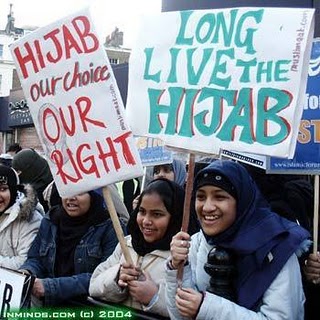
You asked for it–and now you don’t like it?
As they say in Canada, and among liberals here at home, “We don’t need no stinkin’ First Amendment!”
The Quebec legislature is considering a ban on “religious clothing”–that is, say, a cross on a necklace, a yarmulka, or a hijab–for all public employees: civil servants, teachers, nurses, bus drivers, lawyers, “and other people who interact with the public” (https://abcnews.go.com/International/wireStory/religious-symbols-proposal-ignites-fiery-debate-quebec-62377627).
Although “all religions” are to be affected, the focus is on Islam, and especially on the head scarves and other coverings required of some Muslim women. Secular libs don’t like the headwear. They don’t like it, so Muslims can’t have it.
Uh, guys–this is Islam. Or at least some brands of it. If you don’t like it, you shouldn’t be importing it. “You can have your religion, as long as you don’t practice it.” What kind of sense does that make?
If your life turns sour on you because your kid’s teacher has a cross on her bracelet, or the bus driver is a Sikh with a turban, then you need to change your life. Isn’t it funny, though, how the “tolerance” crowd is always the most intolerant bunch of them all?
If this were happening in America, we would call it an unconstitutional attempt to establish secularism as the state religion. But a lot of the Quebec legislators are perfectly comfortable with that. They like the idea of themselves owning the state religion, before which all other religions must bow down and confess themselves inferior and wrong.
Isn’t that what they always accuse us Christians of doing?
Another instance of “be careful what you wish or ask for, you just might get it.
The biggest problem with the “religious clothing” ban is that things like the hijab, niqab, burka, etc. are not actually religious clothing in Islam. They are cultural, and were originally worn to protect from the elements in a desert climate. In the koran, the word hijab is only used a couple of times, and refers to a barrier. Not an article or clothing, but to something like a screen room divider (that women could peer through at the men on the other side, without being seen by the men). A woman is supposed to dress “modestly”, which means hiding the shape of the body and, by Islamic general acceptance, only the face and hands are exposed. How this is to be accomplished is not specified, probably since typical desert clothing already met the requirements.
Which means that followers of Islam can get around the ban by accurately saying that specific items of clothing, such as the hijab, are not religious but cultural, and do not qualify for the ban.
And of course, not all Muslims go in for hijabs and burqas, etc.
This reminds me of Muslims in America taking offence at crosses, even covering up crosses in cemeteries. As a result, my wife and I have purchased a large cross to put on the side of our house facing the street – take that, Allah.